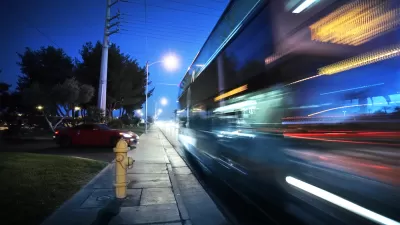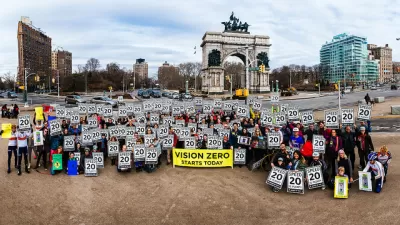Traffic fatalities are on pace to reach 35,000 in the United States this year. Some advocates are saying it's time for traffic engineers to stop blaming the victims.
"US traffic deaths are rising again—fatalities jumped 8.1 percent in the first half of 2015, National Highway Traffic Safety Administration (NHTSA) reports," according to an article by Robert Steuteville.
Steuteville notes that the NHTSA cites "drunken, drugged, distracted and drowsy driving; speeding; and failure to use safety features such as seat belts and child seats," for the increase in tragedy, but he wishes they'd acknowledge another D—the "design of streets and communities." When it comes to design, argues Steuteville, the "bigger is better" approach always wins out—even when all evidence suggests that smaller lanes reduce risks.
"The NHTSA reaction to the current trend in fatalities shows that evidence continues to be ignored. Not everywhere: In the alphabet soup of agencies that govern streets and highways, the Federal Highway Administration (FHWA) recently admitted that wider lanes have no safety benefit on thoroughfares designed for less than 50 mph. This is a small step in the right direction, given that wider lanes degrade safety in urban conditions. It is time for transportation engineers to look in the mirror, own up to the damage done to people and communities, and disavow once and for all the 'bigger is better' approach to urban thoroughfares."
The article surveys some of the influential studies that make the case for a design solutions that could start reducing the loss of life on U.S. streets, roads, and highways before arriving to that frank conclusion. Of particular interest in the definitive 2008 study by Garrick and Marshall, which found that newer cities in California laid out with wider streets and longer blocks have three times more traffic fatalities per capita than cities built before 1950.
That Garrick and Marshall study was also of particular interest to Angie Schmitt at Streetsblog, who deserves a hat tip for sharing this article.
FULL STORY: As traffic deaths rise, blame engineering dogma

Alabama: Trump Terminates Settlements for Black Communities Harmed By Raw Sewage
Trump deemed the landmark civil rights agreement “illegal DEI and environmental justice policy.”

Planetizen Federal Action Tracker
A weekly monitor of how Trump’s orders and actions are impacting planners and planning in America.

How Atlanta Built 7,000 Housing Units in 3 Years
The city’s comprehensive, neighborhood-focused housing strategy focuses on identifying properties and land that can be repurposed for housing and encouraging development in underserved neighborhoods.

In Both Crashes and Crime, Public Transportation is Far Safer than Driving
Contrary to popular assumptions, public transportation has far lower crash and crime rates than automobile travel. For safer communities, improve and encourage transit travel.

Report: Zoning Reforms Should Complement Nashville’s Ambitious Transit Plan
Without reform, restrictive zoning codes will limit the impact of the city’s planned transit expansion and could exclude some of the residents who depend on transit the most.

Judge Orders Release of Frozen IRA, IIJA Funding
The decision is a victory for environmental groups who charged that freezing funds for critical infrastructure and disaster response programs caused “real and irreparable harm” to communities.
Urban Design for Planners 1: Software Tools
This six-course series explores essential urban design concepts using open source software and equips planners with the tools they need to participate fully in the urban design process.
Planning for Universal Design
Learn the tools for implementing Universal Design in planning regulations.
Caltrans
Smith Gee Studio
Institute for Housing and Urban Development Studies (IHS)
City of Grandview
Harvard GSD Executive Education
Toledo-Lucas County Plan Commissions
Salt Lake City
NYU Wagner Graduate School of Public Service





























